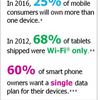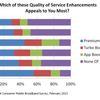In this fourth installment of the Six Degrees of Mobile Data Plan Innovation blog series, Alcatel-Lucent’s Rich Crowe examines application-based data plans. These plans let mobile subscribers use specific applications without consuming their data allowance.
Removing the worry from mobile application use
How would you like to use your favorite mobile applications without having to worry about going over your data limit and paying overage fees? That’s the idea behind application-based data plans. You pay a monthly fee to use one or more specific applications as much as you want. The data consumed by these applications doesn’t count against your data plan. In some cases, your mobile network operator may decide to make selected applications available without impacting your data plan in exchange for a very nominal fee.
Two categories of applications are particularly well suited to application-based pricing. The first are data-hungry applications, like video and multimedia. Today, some consumers use these applications sparingly because they fear going over data limits and incurring overage charges. The second includes core applications that don’t consume much data, such as text-only e-mail or social networking. These applications may be used to introduce subscribers to the world of mobile data.
Plans for data-hungry applications
Recent network analytics show that mobile video applications are rapidly gaining traffic share, particularly on 4G LTE networks. Subscribers who like to watch video on the go, play mobile games or use other data-intensive applications and content must constantly keep track of how much data they use.
Typically, these subscribers either purchase a monthly data allowance more than large enough to cover their usage or try to manage their use and pay an occasional overage. As noted in the first blog in this series, pricing is a major source of data plan dissatisfaction: Subscribers don’t like paying overage fees or feeling like they’ve paid for data they haven’t used. Asking subscribers to manage their data by limiting their use of favored applications will simply add to their frustration.
Application-based plans offer subscribers risk-free access to these data-intensive applications. The flat monthly fee gives subscribers greater price certainty around application and data usage. If subscribers have purchased large data allowances as insurance against going over monthly data allowances, they may even be able to reduce the size of their general data plans. This combination of certainty and freedom can keep subscribers satisfied and improve their perceptions of the mobile operator’s brand.
Application and content providers benefit when subscribers can use their products freely. They don’t have to worry that their applications won’t get used as much when data caps loom and subscribers start prioritizing how and when to use remaining megabytes. Regular use is particularly important for applications that rely on advertising revenue.
The operator benefits by creating an incremental revenue stream – a monthly subscription – for high-value applications. It may also get a bump in overall data usage as subscribers gain the freedom to use their favorite data-hungry applications as much as they want. Subscribers may also use their general data plan more freely if they are less concerned about running over their data caps. What’s more, by combining application-based pricing with introductory discounts, an operator can stimulate application uptake.
Plans for core data applications
Application-based pricing for core mobile data applications helps the operator introduce mobile data to price-sensitive subscribers and encourage uptake by eliminating the risk of bill shock. It’s a situation where everyone wins: The subscriber gets to use mobile data for a nominal fee without worrying about what the bill will be at the end of the month. The included applications gain new users. The operator gains new mobile data subscribers, some of whom can be moved up the value chain once they begin to realize the value of mobile data.
For example, innovative application-based data plans have enabled Turkcell to grow its mobile data customer base and move subscribers up the value chain. In May 2010, the Turkish operator introduced a free plan for Facebook® Zero, a text-only version of Facebook. Once the market was established, Turkcell replaced the free offer with a paid package that included unlimited Facebook data for a set monthly fee. Turkcell now offers Facebook, Twitter and Social Internet packages, each of which includes application data in the monthly price.
Setting appropriate boundaries
Operators need to take care to define and communicate the boundaries of application-based mobile data plans. There can be no surprises if operators hope to maintain customer satisfaction and preserve the worry-free nature of application-based plans. Operators must clearly explain what happens if subscribers initiate actions that take them outside the portions of the application where data use doesn’t count toward their data plan. Operators will also need to remind subscribers of these policies when they do proceed with these actions.
For instance, let’s say an operator offers an application-based plan for Facebook Zero. A subscriber clicks a link in a friend’s status and initiates an outside video stream. Should links like these be deactivated? Should messages warn subscribers that they are leaving the Facebook Zero application and their data plan will be charged if they continue? A general data bucket can help: Subscribers can decide to continue and be covered by their general plan. This is far more satisfying than being surprised with an unexpected data bill at the end of the month.
Partnering for success
Operators can’t create successful application-based plans by themselves. They need to partner with application providers so they can be aware of upcoming changes and determine how these changes may affect data usage and subscriber behavior. For example, Instagram’s new video capabilities significantly increase the data used by the Instagram application. In the following figure, the white area highlights the jump in mobile connections to instagram.com in the days following the introduction of video capabilities. If an operator had offered Instragram in an application-based data plan, it would have wanted advanced notice of this update so it could adjust its own offer to subscribers.
It’s not all or nothing
Application-based pricing doesn’t have to be all or nothing. An operator can offer an application with data included up to a limit. For example, subscribers to KPN’s Spotify® Premium service get an additional monthly data allocation of 500MB to use with the Spotify application. Once a subscriber reaches this application-specific limit, KPN can charge additional Spotify data use against the subscriber’s general data plan. The idea is to provide enough data with the application to meet the needs of most subscribers.
Delivering application-based data plan innovations
Operators need an online charging system and subscriber data manager to implement zero rating and subscriber entitlements. Policy control is required to inform the billing system when to zero rate. Deep packet inspection may be required to examine traffic flows and determine what application is being used and what the data is so the appropriate rating can be applied.
With the right strategy and supporting technologies, operators can develop application-based data plans that generate incremental revenue and spur data usage while providing more certainty to subscribers and application providers.
Up next in our Six Degrees of Mobile Data Plan Innovation series: third-party pays. Follow the blog series on TMCnet. Click here to subscribe to the series and get information and updates about the latest in mobile data plan innovation.
Blog series links:













